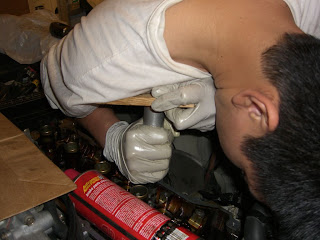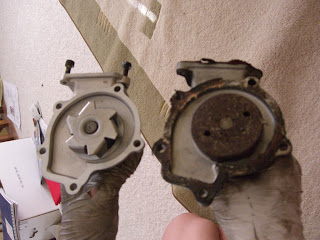Disclaimer: tinkering with gas is dangerous. Below are steps I took to adjust my gas furnace for my own documentation purpose. I decided to share it to public for educational purpose. If you blow up as a result of reading this article, you are on your own.
This is my gas furnace. Manufactured in March 1990. It is 18 years old now. Its efficiency rating is output_btu_per_hour / input_btu_per_hour = 56K BTU/70.5K BTU = 79%. Modern gas furnaces reportedly have 90% or better efficiency. But mine still works and winter in northern virginia is quite mild. I see no reason to replace it yet.
It's been cycling in short interval and I wanted to see if I could do something about that.
The first thing I checked was the flame colour. It should be blue. Orange flame indicates insufficient oxygen or some contaminations. If there is not enough oxygen, the flame will produce soot.
To adjust oxygen level, adjust the air stuter (picture below):
The furnace was a forced air model. The flame heats a heat exchanger which quite similar to a radiator. A blower blows cold air through the exchanger. This heats the air before it comes out of the exhaust register. Adjusting this gas furnace involves balancing the heat put out by the furnace with the cooling the blower provides.
In my case, although the spec says that my furnace could generate at 56K BTU/hour, the blower was not powerful enough to cool the exchanger. My house had 3 intake registers, one on each floor. The ductings was not large enough to reduce the air flow resistance to my blower's capability. If I openned up the blower panel, the blower managed to push enough air to cool the furnace at full power. But obviously I could not run it like that for daily usage.
Adjusting the power of my furnace was done by adjusting the gas flow. Here's my final setting at 3/4 of full flow:
To get at the setting I let the furnace operate as usual while watching the fan limit control switch. I set mine to 100F,140F,200F. I've seen some set at 90F,140F,190F, or 90F,110F,190F. The spec says that the max air outlet temperature is 170F. So, my goal was to get the heat exchanger temp steady at around 170F.
I let the furnace run as normal. I reduced the gas flow if the temperature goes up to the OFF setting (200F) or increased the flow if it held steady at less than 170F. I was gentle when adjusting the flow; a small nudge may be all that's needed.

After about 1/2 hour of tweaking, I managed to have it hold steady at around 170F. It kept at that temperature until the thermostat tells the furnace to shut down. Cycling problem solved. Cost to do that: 2 hours research, 1/2 hour of staring at the control switch.























